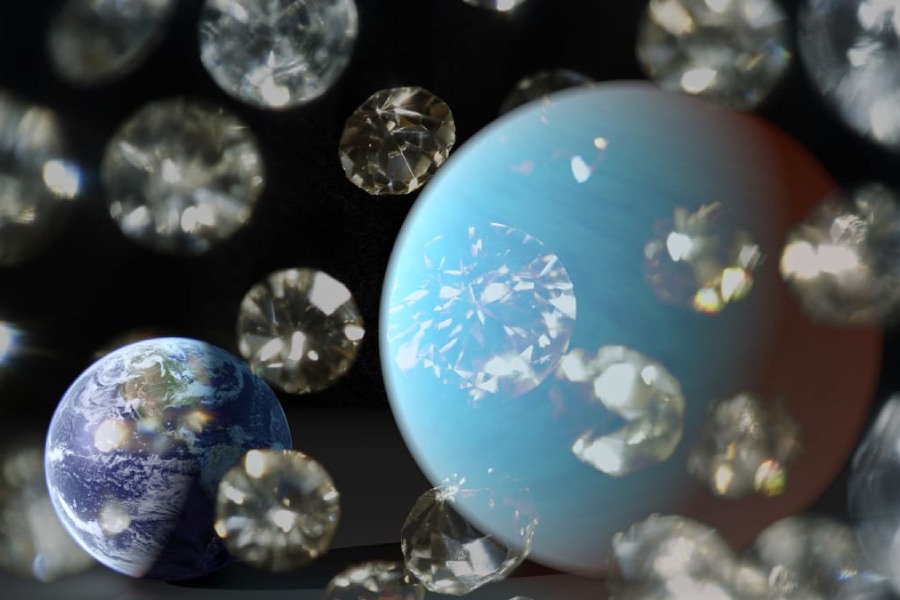Diamonds conjure images of luxury and extravagance here on Earth, but could these sparkling gems also be falling from the sky on other planets? Saturn, with its beautiful rings, certainly looks like a place where diamond rain could happen. But does it rain diamonds on Saturn? What do scientists say? Is it really possible for this fantastical phenomenon to occur?
There are some unique aspects of Saturn. Its chemical composition and weather patterns have led scientists to seriously consider whether diamond rain could actually take place.
The concept of diamonds raining down on an alien world sounds implausible. However, we’ll analyze the scientific theories about how such an event could plausibly take place on Saturn. Additionally, we’ll uncover the mesmerizing life cycle of these rare space gems if and when they occur in any alien environment.

Does It Rain Diamonds on Saturn?
Yes, diamonds may indeed rain on Saturn. This occurs due to the extraordinary conditions on the planet, where methane undergoes intense pressure in the atmosphere, transforming into diamonds.
These diamonds then descend through the atmosphere, resembling rainfall. Unlike Earth’s water-based precipitation, Saturn experiences a fascinating phenomenon. This diamond rain reflects the unique chemistry and environment found on this gas-giant planet.
Exploring Diamond Formation
Why does Saturn rain diamonds? The extreme conditions within Saturn’s turbulent atmosphere create a unique environment for diamond creation. It begins in the upper atmosphere, where UV rays from the sun break down methane into its chemical components. Among these components is carbon.
Powerful updrafts and gravity waves mix these carbon atoms into the deeper, denser layers of the atmosphere. As the carbon descends, the atmospheric pressure steadily increases. The carbon can reach an astounding 10,000 times the pressure felt at Earth’s surface.
Under these immense pressures pervading Saturn’s lower atmosphere, the carbon atoms are squeezed into close, organized arrangements. These arrangements have the specific crystalline structure of a diamond.
The turbulent winds scouring through Saturn’s clouds shape and polish the carbon crystals, allowing flawless diamonds to form. This perfect alignment of heat, pressure, and carbon availability creates a rare phenomenon.
Powerful mixing winds within Saturn’s atmosphere contribute to this unique environment. Together, they enable Saturn to produce diamond rain within the extreme environment of a gas-giant planet.
Deep Atmospheres and Pressure Conditions
Far below the cloud tops of Saturn lies a complex system of deep atmospheric layers. Starting at around 160 kilometers down, water clouds take shape in an atmosphere still similar to Earth’s. But sinking deeper, the compounds found in the atmosphere form other cloud decks.
Ammonium hydrosulfide crystals appear at 240 km, followed by ammonia ice clouds at 270 km. Temperatures increase with depth, reaching incredible values. At 10,000 km deep, temperatures exceed 15,000°F. Pressure also ramps up in the depths.
Halfway to the planet’s core, pressures reach 10 million times that of Earth’s. In these extreme environments, common carbon atoms are compressed and fused into solid diamond structures. The deeper into Saturn’s atmosphere, the greater the pressure squeezing carbon atoms into diamond crystals.
So while the upper cloud layers churn and roil, they overlay an even more turbulent realm deep below. Saturn has an extremely alien environment. The crushing pressures and searing temperatures allow Saturn to perform the chemical magic of producing glittering gemstones.
Exploring the Possibility of Liquid Diamonds
The intense pressures and temperatures deep within Saturn have led scientists to theorize that diamonds could exist in liquid form. At around 10,000 kilometers below Saturn’s cloud tops, temperatures exceed 15,000°F. Pressures at this depth reach 10 million times Earth’s atmosphere.
These extreme conditions allow carbon atoms to separate from methane and hydrogen compounds and come together to form diamonds. But with increasing depth, scientists calculate the diamonds would melt into an exotic, fluid state while retaining their molecular structure.
Computer simulations suggest liquid diamonds at these depths would flow like water yet remain optically transparent. The viscosity would be similar to liquid metals. So deep beneath the layers of swirling gas, there may exist a sea of churning liquid diamonds on Saturn.
Biggest Diamonds Discovered on Saturn
The hostile environment within Saturn has birthed some extraordinarily large diamonds. In 2011, NASA’s Cassini spacecraft detected evidence of icy diamond hailstones. These hailstones were up to 2 centimeters wide and were found falling through Saturn’s clouds.
These chunky gems represent the largest diamonds ever discovered in planetary systems. Cassini also found smaller frozen diamonds in the gas giant’s atmosphere. These diamonds ranged from 1 to 4 microns wide. They still dwarf the size of terrestrial diamonds used in jewelry.
Scientists believe the sheer scale of Saturn’s atmospheric forces enables the creation of such massive diamonds. The powerful gravity and winds shape the growing carbon crystals into gigantic structures. These Saturnian super-diamonds demonstrate how the same processes produce tiny gems on Earth.
Under the right conditions, they can foster the growth of record-breaking stones. The mammoth diamonds raining through Saturn’s clouds provide a window into the extreme chemistry and forces at work within the planet’s dynamic atmosphere.
Conclusion
As we have seen, Saturn’s turbulent atmosphere harbors a truly astonishing secret – diamond rain. The breakup of methane in Saturn’s upper clouds initiates this phenomenon. Subsequently, carbon crystals are forged in the extreme depths of the planet.
The precise alignment of conditions on Saturn enables the creation of diamonds on a cosmic scale. The diamond rainstorms help reveal Saturn’s hidden mechanisms. These include the powerful winds, immense pressures, and complex chemistry churning far beneath the planet’s calm surface.
Does it rain diamonds on Saturn? Absolutely. By uncovering this phenomenon, we gain insight into the marvels possible on distant worlds. The fleeting jewels dropping through Saturn’s clouds exemplify the wonders of our solar system.
